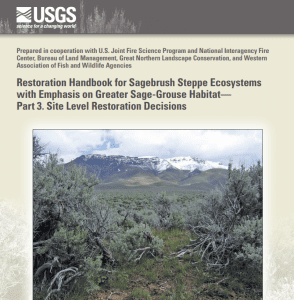Restoration
View article.
Skillful seasonal climate forecasts could greatly improve the cost efficiency of management treatments by limiting revegetation activities to time periods where forecasts suggest higher probabilities of successful seedling establishment. Climate-change projections are key to the application of current environmental models for development of mitigation and adaptation strategies and for management practices that require a multidecadal planning horizon. Adoption of new weather technology will require collaboration between land managers and revegetation specialists and modifications to the way we currently plan and conduct rangeland rehabilitation and restoration in the Intermountain West.
View abstracts.
Abstracts of Recent Papers on Range Management in the West. Prepared by Charlie Clements, Rangeland Scientist, USDA Agricultural Research Service, Reno, NV
View report.
In this report, guidelines are presented for restoring whitebark pine under future climates using the rangewide restoration strategy structure. The information to create the guidelines came from two sources: (1) a comprehensive review of the literature and (2) a modeling experiment that simulated various climate change, management, and fire exclusion scenarios. The general guidelines presented here are to be used with the rangewide strategy to address climate change impacts for planning, designing, implementing, and evaluating fine-scale restoration activities for whitebark pine by public land management agencies.
View article.
Stephen Pyne is Regents Professor in the School of Life Sciences at Arizona State University. This is an abridged version of a piece that appeared on The Conversation; to read the entire piece, go to theconversation.com
View fact sheet.
In this work, researchers examined understory plant community responses to ecological restoration treatments at two pinyon-juniper woodland sites in northwestern Arizona. We asked the following questions: 1) do restoration treatments, that include tree thinning prescriptions guided by reference conditions, scattering thinning slash, and seeding, lead to increases in plant cover and species richness; and 2) how do understory responses differ across sites with contrasting soils characteristics?
View abstracts.
These abstracts of recent papers on range management in the West were compiled by Charlie Clements, Rangeland Scientist, USDA Agricultural Research Service.
View article.
This study used three years of survey data to examine the relationship between gas field development density and pygmy rabbit site occupancy patterns on four major Wyoming gas fields (Continental Divide–Creston–Blue Gap, Jonah, Moxa Arch, Pinedale Anticline Project Area). The study found that pygmy rabbits in southwestern Wyoming may be sensitive to gas field development at levels similar to those observed for greater sage-grouse, and may suffer local population declines at lower levels of development than are allowed in existing plans and policies designed to conserve greater sage-grouse by limiting the surface footprint of energy development. Buried utilities, gas well pads, areas adjacent to well pads, and well pad access roads had the strongest negative correlation with pygmy rabbit presence and abundance. Minimizing the surface footprint of these elements may reduce negative impacts of gas energy development on pygmy rabbits.
View abstracts.
These abstracts summarize rangeland management topics in the West.
View article.
This study used a genecological approach to explore genetic variation for survival in Artemisia tridentata (big sagebrush). It found evidence of adaptive genetic variation for survival. Plants from areas with the coldest winters had the highest levels of survival, while populations from warmer and drier sites had the lowest levels of survival. Survival was lowest, 36%, in the garden that was prone to the lowest minimum temperatures. These results suggest the importance of climatic driven genetic differences and their effect on survival. Understanding how genetic variation is arrayed across the landscape, and its association with climate can greatly enhance the success of restoration and conservation.
View handbook.
This handbook walks managers and practitioners through a number of site-specific decisions managers face before selecting the appropriate type of restoration. This site-level decision tool for restoration of sagebrush steppe ecosystems is organized in nine steps.
- Step 1 describes the process of defining site-level restoration objectives.
- Step 2 describes the ecological site characteristics of the restoration site. This covers soil chemistry and texture, soil moisture and temperature regimes, and the vegetation communities the site is capable of supporting.
- Step 3 compares the current vegetation to the plant communities associated with the site State and Transition models.
- Step 4 takes the manager through the process of current land uses and past disturbances that may influence restoration success.
- Step 5 is a brief discussion of how weather before and after treatments may impact restoration success.
- Step 6 addresses restoration treatment types and their potential positive and negative impacts on the ecosystem and on habitats, especially for greater sage-grouse. We discuss when passive restoration options may be sufficient and when active restoration may be necessary to achieve restoration objectives.
- Step 7 addresses decisions regarding post-restoration livestock grazing management.
- Step 8 addresses monitoring of the restoration; we discuss important aspects associated with implementation monitoring as well as effectiveness monitoring.
- Step 9 takes the information learned from monitoring to determine how restoration actions in the future might be adapted to improve restoration success.


